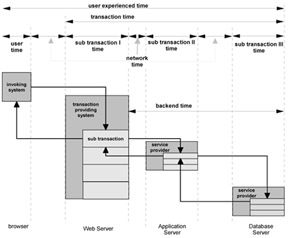Chapter 1: Transaction Management Imperatives
|
| < Day Day Up > |
|
This chapter provides an overview of the business imperatives for looking at transaction performance. We also use this chapter to discuss, in broader terms, the topics of system management and availability, as well as performance monitoring.
1.1 e-business transactions
In the Web world, users perceive interacting with an organization or a business through a Web-based interface as a single, continuous interaction or session between the user's machine and the systems of the other party, and that is how it should be. However, the interaction is most likely made up of a large number of individual, interrelated transactions, each one providing its own specific part of the complex set of functions that implement an e-business transaction, perhaps running on systems owned by other organizations or legal entities.
Figure 1-1 shows a typical Web-based transaction, the resources used to facilitate the transaction, and the typical components of a transaction breakdown.

Figure 1-1: Transaction breakdown
In the context of this book, we will differentiate between different types of transactions depending on the location of the machine from which the transaction is initiated:
| Web transaction | Originate from the Internet, thus we have no predetermined knowledge about the user, the system, and the location of the transaction originator. |
| Enterprise transaction | Initiated from well-known systems, most of which are under our control, and knowledge of the available resources exists. Typically, the systems initiating these types of transactions are managed by our Tivoli Management Environment. |
| Application transaction | Subtransactions that are initiated by the application-provisioning Web transactions to the end users. Application transactions are typically, but not always, also enterprise transactions, but also may initiate from third-party application servers. |
| A typical application transaction is a database lookup performed from a Web application server, in response to a Web transaction initiated by an end user. |
From a management point of view these transaction types should be treated similarly. Responsiveness from the Web application servers to any requester is equally important, and it should not make a difference if the transaction has been initiated from a Web user, an internal user, or a third-party application server. However, business priorities may influence the level of service or importance given to individual requestors.
However, it is important to note that monitoring transaction performance does not in any way obviate the need to perform the more traditional systems management disciplines, such as capacity, availability, and performance management. Since the Web applications are comprised of several resources, each hosted by a server, these individual server resources must be managed to ensure that they provide the services required by the applications.
With the myriad servers (and exponentially more individual resources and components) involved in an average-sized Web application system, management of all of these resources is more an art than a science. We begin by providing a short description of the challenges of e-business provisioning in order to identify the management needs and issues related to provisioning e-business applications.
|
| < Day Day Up > |
|
EAN: 2147483647
Pages: 105